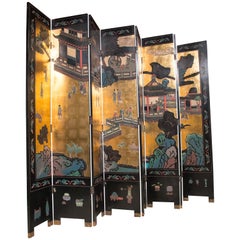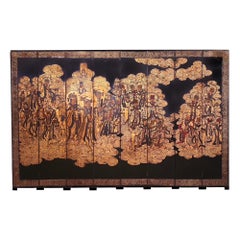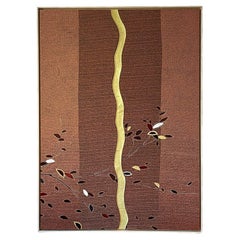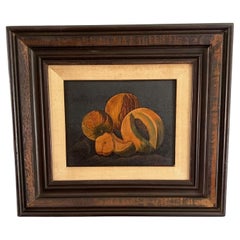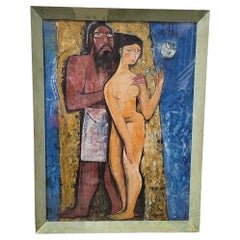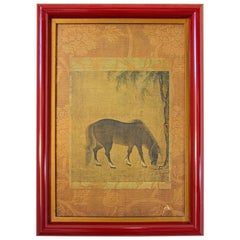Mid-20th Century Paintings and Screens
to
29
127
37
190
16
11
4
2
2
1
167
679
898
154
309
190
108
39
3
32
13
12
26
29
28
26
8
85
77
58
48
45
144
109
78
27
17
190
190
190
9
2
1
1
1
Period: Mid-20th Century
Large 8-Panel Coromandel Screen
Located in Stamford, CT
A grand eight panel Coromandel screen. The screen has mostly a gilt background with a few architectural structures and figures. A very good looking screen.
Category
Asian Vintage Mid-20th Century Paintings and Screens
Materials
Wood
20th Century Chinese Coromandel Black Gilt Eight-Panel Screen Immortals Sky Gods
Located in Farmington Hills, MI
We are very pleased to offer a monumental 8ft, eight panel room divider, circa the 20th century. This beautiful double-sided hardwood screen showcases a rich, black lacquer finish an...
Category
Chinese Chinese Export Mid-20th Century Paintings and Screens
Materials
Hardwood, Lacquer
Vintage kimono textile art "Autumn branches ~ Kintsugi ~" by ikasu Brown, Japan
By Kimono ikasu
Located in Setagaya City, JP
The frame for this work is made of paulownia wood taken from antique Kiritansu - chest-of-drawers for kimono.
I use antique kiritansu that can’t be used as furniture anymore to crea...
Category
Japanese Japonisme Vintage Mid-20th Century Paintings and Screens
Materials
Gold Leaf
Vintage Painting Still Life with Fruit - Study of Mellons
Located in San Diego, CA
The oil on canvas painting majestically depicts a group of mellons in different sizes. The scene is depicted against a dark ground, however the artist has included dimension by focus...
Category
American British Colonial Vintage Mid-20th Century Paintings and Screens
Materials
Wood, Paint, Canvas
The Temptation 1957 by C J Anthony Doss
Located in Dallas, TX
PRESENTING a GLORIOUS Contemporary piece of Art by a recognized Indian Master – C J Anthony Doss – The Temptation 1957 .
This piece has impeccable Provenance !
It was purchased by a Private Dallas Collector at Sotheby’s New York Auction on 20th September 2005. Sale No: 8111 Lot No. 223.
Sotheby’s operate a twice yearly auction of Southeast Asian Art & Antiquities in New York in the months of March and September.
This sale was titled “Indian and Southeast Asian Art”.
The Lot is described as: “C.J. Anthony Doss (b. 1933) THE TEMPTATION. Signed and dated ‘C J A Doss/57’ lower right.
Oil on canvas laid on board.
27.5 by 20.5 in (69.9 by 52 cm.)
The Provenance is given as: “Property from the Collection of Mr. Artur Isenberg”.
The painting carried an Auction estimate of USD 2,000 to USD 4,000.
Allowing for inflation alone this would be over $6,000 in today’s value.
As an added bonus and proof of authenticity the painting still retains it’s original Sotheby’s Lot No. Label.
It has substantially increased in value over the years as a HIGHLY DESIRABLE piece from an exhibited and highly collected Modern Indian Master painter.
C.J. Anthony Doss is a very highly regarded and widely exhibited, Indian painter. He was born in 1933 and died in 2008.
DAG Modern in Mumbai featured Doss’s work.
Doss represented India at biennales in Paris and Sao Paulo. He was also a prominent member of the South Indian Society of Painters. His works are in Indian museums...
Category
Indian Mid-Century Modern Mid-20th Century Paintings and Screens
Materials
Canvas, Wood, Paint, Paper
Asian Chinese Horse Print
By Rajhastani
Located in North Hollywood, CA
Asian Chinese horse print in a red wood frame.
Chinese lithograph print study of a horse.
Well framed, no glass.
Size: 21" x 15".
From an esta...
Category
Chinese Chinese Export Mid-20th Century Paintings and Screens
Materials
Paper
Japanese Two Panel Screen Late Autumn Forest, Rare Obara Paper Art Screen
Located in Hudson, NY
A masterful landscape made entirely of carefully arranged mulberry paper fibers in a Japanese art practice called Obara. Accented with gold leaf. Incredible craftsmanship and a wonderful rendering of bare trees. Made by Yamauchi Issei (b. 1929), stamped in the corner. Issei is well known throughout Japan as the leading artist in Obara Paper Art. Starting in 1948, he apprenticed with Fuji Tatsukichi, a leading proponent of the arts and crafts movement in Japan who worked to Revive many cultural traditions on the brink of extinction. Issei started exhibiting in the Nitten in 1953, won the Gold Medal in 1963, and eventually became a juror. His artwork was given as a gift to the Showa Emperor of Japan, as well as dignitaries such as General Douglas MacArthur...
Category
Japanese Showa Mid-20th Century Paintings and Screens
Materials
Gold Leaf
Japanese Two Panel Screen: Summer Flowers
Located in Hudson, NY
Screen depicts Summer flowers and birds on gilded silk. Signature reads: Konishi Fukunen. Notes about Artist: Konishi Fukunen (1887-1959) was born the second son of the Paper mounting specialist Konishi Uhei in Takeo, Fukui prefecture in the mid Meiji period. In 1902 he was sent to Kyoto to study painting under Suzuki Shonen...
Category
Japanese Mid-20th Century Paintings and Screens
Materials
Silk
Japanese Mid-Century Modern 4-Panels Screen w/ Flower Cart, Ca. 1950
Located in New York, NY
Japanese Mid-Century Modern 4-Panels Screen w/ Flower Cart, Ca. 1950
DIMENSIONS
Length: 71.5 inches
Height: 36.5 inches
Category
Japanese Japonisme Vintage Mid-20th Century Paintings and Screens
Materials
Wood
Japanese Two Panel Screen: Pine and Mountain Landscape By Muta Akira
Located in Hudson, NY
By rivers edge at sunrise. By: Muta Akira. Mica paint on canvas. Exhibited in the 1960 Nitten exhibition.
Category
Japanese Mid-20th Century Paintings and Screens
Materials
Canvas
Set of 4 Modernist Original Art Portraits 1950s
Located in San Diego, CA
Incredible set of 4 original art portraits from the 1950s. These original pieces are signed and unique in their style. The use of strong, unblended colors and a somewhat flattened ...
Category
American Mid-Century Modern Vintage Mid-20th Century Paintings and Screens
Materials
Paint
$1,150 / set
Indian Ceremonial Hindu Deity Hand-Painted on Canvas in Gilded Frame
Located in Yonkers, NY
A framed Indian ceremonial Hindu deity from the mid 20th century, hand-painted on canvas. Created in India during the midcentury period, this scene, hand-p...
Category
Indian Mid-20th Century Paintings and Screens
Materials
Glass, Canvas
Pair of Chinese Watercolour on Silk Paintings, China, c.1940
Located in London, GB
A pair of Chinese watercolour on silk paintings, China, C.1940.
Framed in its original silk brocade border.
Presented unframed.
In exce...
Category
Chinese Showa Mid-20th Century Paintings and Screens
Materials
Silk, Paint
Pair Mid Century Japanese Framed Signed Oshie Art C.1950
Located in London, GB
Pair Mid Century Japanese Framed Signed Oshie Relief Art C.1950
Oshie decorative art meaning “pressed pictures” that goes back to the Edo Period (1603-1868) consisting of paper and ...
Category
Japanese Mid-20th Century Paintings and Screens
Materials
Textile, Acrylic, Paper
Japanese Signed Stamped Hand Drawn Silk Obi Sash Belt with Crow, Mid-1900
Located in Studio City, CA
A wonderful handmade vintage silk Obi sash/ belt featuring a rather unique hand-drawn scene with a crow and trees.
Signed and stamped by the artist...
Category
Japanese Showa Mid-20th Century Paintings and Screens
Materials
Silk
Vintage Japanese Ukiyo-e Print of Kinkaku-ji in Snow by Tokuriki Tomikichiro
By Tokuriki Tomikichiro 1
Located in Philadelphia, PA
A fine vintage Japanese woodblock print.
Entitled "Kinkaku-ji in Snow".
By Tomikichiro Tokuriki (1902 - 1999). Tokuriki came from a...
Category
Japanese Showa Vintage Mid-20th Century Paintings and Screens
Materials
Paper
Vintage Japanese Ukioye Shunga Erotic Hand Painted Scoll 31"
Located in Dayton, OH
Large vintage mid 20th century ukioo-e style shunga / Japanese erotic scroll featuring six panels of amorous Kama Sutra style scenes hand painted on silk with green and gold ribbon dividers.
Shunga (春画) is a type of Japanese erotic art...
Category
Japanese Chinoiserie Mid-20th Century Paintings and Screens
Materials
Wood, Paper
$300 Sale Price
20% Off
Vietnamese Scene by French Artist J Buttin
Located in Jersey City, NJ
J Buttin was a French artist who lived in Indochina. This painting shows water carrier women under banana leaves. It is signed.. The painting has been recently cleaned by a professio...
Category
French Vintage Mid-20th Century Paintings and Screens
Materials
Canvas, Wood
Japanese Two Panel Screen Moon Rising Over Turbulent Ocean Landscape
Located in Hudson, NY
Contemporary sumie (ink) painting on silver.
Category
Japanese Showa Vintage Mid-20th Century Paintings and Screens
Materials
Paper
Japanese 2-Panel 'Shunga' Screen with Finely Painted Erotic Depictions of Lovers
Located in Prahran, Victoria
A very finely painted two panel 'shunga' screen with scenes of naked erotic lovers in union.
The scene on the left panel simply depicts the lovers in ...
Category
Japanese Showa Mid-20th Century Paintings and Screens
Materials
Wood, Paper
Japanese Asian Signed Four-Panel Folding Byobu Showa Screen Lady Murasaki Genji
Located in Studio City, CA
A gorgeous and quite striking four-panel Japanese Byobu folding screen featuring an elegantly clad Lady Murasaki, the Japanese novelist, (and famed author of the classic "Tale of Gen...
Category
Japanese Showa Mid-20th Century Paintings and Screens
Materials
Gold Leaf
Mid-Century Balinese Painting on Silk with Bamboo and Woven Rattan Frame, 1960s
Located in Roma, IT
Spectacular large Balinese Painting on Silk with an outstanding bamboo and woven rattan frame. This marvellous painting was realized in Bali around the 1960s and is signed on the bot...
Category
Italian Mid-Century Modern Mid-20th Century Paintings and Screens
Materials
Bamboo, Wicker, Cane, Rattan, Silk, Glass, Paint
Paravento giapponese a sei pannelli dipinto su foglia d'argento
Located in Brescia, IT
Paesaggio giapponese: paravento a sei pannelli dipinto a pigmenti minerali su foglia d'argento.
Elegante e moderno esempio di arte orientale senza figure uccelli o fiori.
Paravento b...
Category
Japanese Showa Mid-20th Century Paintings and Screens
Materials
Silver Leaf
Middle Eastern Miniature Painting on Shell
Located in North Hollywood, CA
Hand Painted Asian Persian miniature painting on a sea oyster shell.
Middle Eastern Moorish design miniature painting on shell, very fine ...
Category
Asian Moorish Mid-20th Century Paintings and Screens
Materials
Shell, Mother-of-Pearl
Pair of Stunning Vintage Soapstone & Mother of Pearl Geisha Girl Wall Panels
Located in West Sussex, Pulborough
We are is delighted to offer for sale this stunning pair of vintage circa 1940s Chinese chinoiserie wall plaques depicting Geisha girls in soa...
Category
Chinese Chinoiserie Vintage Mid-20th Century Paintings and Screens
Materials
Soapstone
Bali Hindu Textile Framed 'Kamasan' Painting, Indonesia C. 1940
Located in Jimbaran, Bali
An early 20th century 'Kamasan' cotton textile painting from Bali, Indonesia. The hand-painted image has great detail and depicts Balinese Hindu mythology. It is stretched over a can...
Category
Balinese Folk Art Vintage Mid-20th Century Paintings and Screens
Materials
Cotton, Paint
After a 16th Century Indian Mughal Style Painting
By Rajhastani
Located in North Hollywood, CA
Mughal print after a 16th century Indian hand painting in wood gilt frame.
Indian Mughal School, illuminated
India Rajasthan Indian Mughal School, illumi...
Category
Indian Agra Mid-20th Century Paintings and Screens
Materials
Paper
Japanese Two-Panel Screen: Bamboo in the Moonlight on Silver
Located in Hudson, NY
Modern painting of the moon through a bamboo grove. Mineral pigments on silver.
Category
Japanese Mid-20th Century Paintings and Screens
Materials
Silk, Wood, Paper
Haku Maki Japanese Woodblock "Poem 69-17" Signed
By Haku Maki
Located in New York, NY
Haku Maki (1924-2000) Japanese Woodblock Poem 69-17. This art is from the Poem collection. Signed and numbered in pencil. Edition 15/86. Color wood blocking with embossing. Measures ...
Category
Japanese Vintage Mid-20th Century Paintings and Screens
Materials
Paper
1970s Swedish Floral Wall Hanging
Located in Berkeley, CA
Origin: Sweden
Designer: Unknown
Manufacturer: Tidstrands
Era: 1970s
Materials: Wool
Measurements: 29? wide x 36.5? tall
Condition: In excellent original condition.
Category
Swedish Mid-Century Modern Mid-20th Century Paintings and Screens
Materials
Wool
Vintage Chinese Colored stone Ansestoral Court Scene Panel
Located in Douglas Manor, NY
1765 Chines panel hand painted with applied colored stone ansestoralfigures in a court scene
Category
Vintage Mid-20th Century Paintings and Screens
Materials
Stone
Rare & Collectable Vintage Chinese Export Hardstone Folding Screen Room Divider
Located in West Sussex, Pulborough
We are delighted to offer for sale this extremely well made and highly collectable Chinese Export circa 1940’s Hardstone room divider folding screen.
A truly stunning and exquisit...
Category
Chinese Chinese Export Vintage Mid-20th Century Paintings and Screens
Materials
Stone
$19,190 Sale Price
25% Off
Lovely 20th Century Sen'yo Ogawa Scroll Painting Japan Artist Flowers Painted
Located in Amsterdam, Noord Holland
Sen'yo Ogawa
1882-1971
Japan painter. Kyoto production. Name Tasaburo. After served as apprentice of the Buddhist teacher, I learned a Movie to Chu Asai, exhibited oil paintings to...
Category
Japanese Showa Mid-20th Century Paintings and Screens
Materials
Silk
$1,477 Sale Price
25% Off
Landscape and Waterfall Nihonga Scene Showa Period Scroll Japan Artist
Located in Amsterdam, Noord Holland
Some errors will occur in the dimensions. Please understand.
Status: The condition is good, but please understand stains, wrinkles, and stains.
Measures: Axis vertical 193 cm, hori...
Category
Japanese Showa Vintage Mid-20th Century Paintings and Screens
Materials
Silk
$811 Sale Price
20% Off
Japanese Two-Panel Screen Spring Flowers
Located in Hudson, NY
A vibrant celebration of spring using a colorful ensemble of coxcomb, irises, lilies, hybiscus, and a blossoming cherry tree. Great examples of "tarashikomi" or "painting-in", a Rim...
Category
Japanese Showa Vintage Mid-20th Century Paintings and Screens
Materials
Silk, Paper
Multicolored Batik with Butterflies on frame. Central Java
Located in Antwerp, BE
Multicolored batik with butterflies and flowers on blue background, on frame.
Central Java, circa 1970. Signed Pandik.
Exquisite Batik Wall Decoration w...
Category
Indonesian Hollywood Regency Mid-20th Century Paintings and Screens
Materials
Textile, Wood
Philippine Handcrafted Solid Mahogany Carved Screen, Philippines, 1930
Located in Madrid, ES
Traditional Philippine hand carved solid Mahogany 3-panel see-through screen.
Category
Philippine Japonisme Vintage Mid-20th Century Paintings and Screens
Materials
Wood
Japanese Two Panel Screen: Flowers by River's Edge
Located in Hudson, NY
Mineral pigments on gilded silk with gilded bronze hardware. Signature reads: Shunkan.
Category
Japanese Vintage Mid-20th Century Paintings and Screens
Materials
Bronze
Screen With 6 Panels In Lacquered And Carved Wood - Double-Sided Decorations -
Located in Brussels, BE
Screen With 6 Panels In Lacquered And Carved Wood - Double-Sided Decorations - China - Circa 1950
Category
Chinese Vintage Mid-20th Century Paintings and Screens
Materials
Wood
Vintage kimono textile art "Sunset Timelapse ~Ephemerality~" by ikasu Red, Japan
By Kimono ikasu
Located in Setagaya City, JP
The art piece uses two sides - front and reverse - of the same kimono, to show beautiful sea surrounding Japan, in hues and in late sunset, as a timelapse.
The frame for this work is made of paulownia wood taken from antique Kiritansu - chest-of-drawers for kimono.
I use antique kiritansu that can’t be used as furniture anymore to create basis and frames for my works. It adds them even more authentic atmosphere of traditional wabisabi spirit. Can you feel it?
<< Period / Story >>
The kimono used in this piece was originally crafted during Showa period (around 1960ies).
<< Explanation and meaning of pattern and colors >>
Sea waves, depicted in two color variations here, are a symbol of transience and Impermanence in Japanese culture. The ebb and flow of the tides, the ever-changing currents, and the relentless motion of the waves serve as reminders of the fleeting nature of life. This artwork featuring the sea convey themes of impermanence, reminding viewers to cherish the present moment and appreciate the beauty of life's fleeting moments.
The theme of impermanence is strengthen by two colors of the sea - the lighter in early hues and the darker when the sun is just about to set in the sea.
<< About the frame >>
This artwork frame is crafted from paulownia wood, a uniquely Japanese material closely tied to the world of kimonos, and it serves to convey the refined beauty of Japanese nature.
Paulownia wood is known as the lightest wood in Japan, prased for its natural luster, resistance to moisture, and resilience against cracking. Since ancient times, it has been used in crafting furniture, chests, and musical instruments.
Paulownia wood is closely linked to kimono culture. During the Edo period (17th cent.~), it became customary to store cherished kimonos in paulownia chests...
Category
Japanese Japonisme Vintage Mid-20th Century Paintings and Screens
Materials
Silk, Wood
N’guyen Phan Long, a pair of drawings on paper, 1946
Located in Paris, FR
Price for both.
Signed at the bottom right.
Vietnam, 1946.
Dimensions
H : 33 cm L : 31 cm
H : 12.9 in W : 12.2 in
Category
Vietnamese Art Deco Vintage Mid-20th Century Paintings and Screens
Materials
Paper
Japanese Two Panel Screen: Flowers by River's Edge
Located in Hudson, NY
Mineral pigments on gilded silk with gilded bronze hardware. Signature reads: Shunkan.
Category
Japanese Vintage Mid-20th Century Paintings and Screens
Materials
Bronze
Bali Hindu Textile Framed 'Kamasan' Painting, Indonesia C. 1950
Located in Jimbaran, Bali
This striking vintage Balinese Kamasan painting, rendered on handwoven cotton, beautifully captures the timeless elegance of classical Wayang-style st...
Category
Balinese Folk Art Vintage Mid-20th Century Paintings and Screens
Materials
Cotton, Paint
Vintage Chinese Two Panel Colored stone Ansestoral Court Scene Panels
Located in Douglas Manor, NY
1764 Two individual Chinese panels hand painted with applied colored stone ansestoral figures in a court scene
Each panel 14x34"
Total with of 2 panels 28"
Price is for 2 panels
Category
Vintage Mid-20th Century Paintings and Screens
Materials
Stone
$1,450 Sale Price / set
23% Off
Blue Robert Crowder Screen
Located in Los Angeles, CA
Screen by Robert Crowder. With blue background hand painted pink roses with birds and butterflies. Signed on the bottom right corner. Each in...
Category
American Vintage Mid-20th Century Paintings and Screens
Materials
Paint
$16,000
VIntage kimono textile art " Wish for prosperity " by ikasu Gold, Black, Japan
By Kimono ikasu
Located in Setagaya City, JP
This work is inspired by traditional Japanese nature colors symbolism, and is framed in paulownia wood originally used for a kimono chest-of-drawers.
It is filled with storytelling ...
Category
Japanese Japonisme Vintage Mid-20th Century Paintings and Screens
Materials
Silk, Wood
Pair of Japanese Screens
Located in Schellebelle, BE
Exceptional pair of Japanese screens, 20th century
Six parts, six times 45 cm wide
Gold spotted paper with parts of old screens.
Category
Japanese Mid-20th Century Paintings and Screens
Materials
Paper
$6,566 / set
FiVE CHINESE CH'IEN LUNG PERIOD 1736-1796 WATERCOLOUR BIRD PIANTINGS FRAMED
Located in West Sussex, Pulborough
Royal House Antiques
Royal House Antiques is delighted to offer for sale this lovely suite of five original Watercolour paintings dating to the Ch'ien Lung Period 1736-1796 publishe...
Category
Chinese Chinese Export Vintage Mid-20th Century Paintings and Screens
Materials
Paper
Framed Pair of Vintage South Asian Paintings - Gouache & Gilt - 20th Century
Located in Chatham, ON
Pair of vintage South Asian gouache paintings on paper with gilt highlights - contained in a single bevel edged matte and frame under glass - mid 20th century.
Excellent vintage con...
Category
Indian Anglo-Indian Mid-20th Century Paintings and Screens
Materials
Glass, Wood, Paint, Paper
Japanese Two Panel Screen Plain Mulberry Paper
Located in Hudson, NY
(no image) on lattice frame. Pair available; Sold seperately.
Category
Japanese Mid-20th Century Paintings and Screens
Materials
Paper
Japanese Two-Panel Screen "Women in Western Dress"
Located in Hudson, NY
Japanese Two Panel Screen: Women in Western Dress, Nihonga style painting of two young women in Western style summer clothing, sitting at water's edge and cooling off by putting their feet in the water. Showa period painting...
Category
Japanese Showa Vintage Mid-20th Century Paintings and Screens
Materials
Wood, Paper
Vintage kimono textile art "Marble Story ~ Healing ~" by ikasu Grey, Japan
By Kimono ikasu
Located in Setagaya City, JP
This work uses a vintage kimono fabric with marble pattern, that makes it look like a real piece of marble.
The line in the middle symbolizes “kintsugi” - concept of wabi-sabi, which values imperfection, impermanence, and the beauty of aging.
It is elegantly framed with paulownia wood originally used for kimono chest-of-drawers, and is filled with storytelling and sense of luxury.
I used pieces of kimono that could no longer be used as clothing and kiritansu chest-of-drawers that would normally be discarded to create the ultimate upcycled piece.
<< Explanation and meaning of pattern and colors >>
Kintsugi (金継ぎ), which translates to "golden joinery" or "golden repair," is a traditional Japanese art form of repairing broken pottery with lacquer mixed with powdered gold, silver, or platinum. I used this tecnique here to "repair" antique kimono by transforming it into art work. Beyond its literal meaning of mending broken ceramics, kintsugi carries profound philosophical and cultural significance in Japanese tradition:
・Embracing Imperfection: Kintsugi celebrates imperfection and impermanence. Rather than disguising or concealing flaws, it highlights them, treating the breakage as part of the object's history. This philosophy encourages acceptance of imperfection as an essential aspect of life, beauty, and human experience.
・Wabi-Sabi Aesthetic: Kintsugi embodies the principles of wabi-sabi, an aesthetic worldview centered on the acceptance of transience and imperfection. Wabi-sabi values simplicity, authenticity, and the beauty of things that are imperfect, impermanent, and incomplete. Kintsugi exemplifies these principles by turning what might be considered flaws into features that enhance the object's beauty and character.
・Resilience and Transformation: The act of repairing broken things with precious metals symbolizes resilience and transformation. Instead of discarding or replacing the broken object, kintsugi honors its history and transforms it into something new and valuable. This reflects broader philosophical themes of overcoming adversity, finding beauty in imperfection, and embracing change.
・Honoring the Past: Kintsugi preserves and honors the history of the object. Rather than erasing or ignoring its past, it acknowledges and celebrates it. This aspect of kintsugi can be seen as a metaphor for honoring our own personal histories, including the challenges and setbacks we have faced, and recognizing how they have shaped us into who we are today.
・Spiritual and Philosophical Symbolism: Kintsugi has spiritual and philosophical implications, reflecting concepts such as the interconnectedness of all things, the cycle of life and death, and the pursuit of harmony and balance. The process of repairing broken objects with precious metals is seen as a metaphor for spiritual growth, enlightenment, and the journey towards wholeness.
Overall, kintsugi represents not only a practical technique for repairing ceramics but also a profound philosophical and cultural perspective on life, beauty, and the human experience. It embodies values such as resilience, acceptance, and the transformative power of embracing imperfection.
<< Characteristics of the fabric >>
This vintage textile is hand-painted with a traditional painting technique where the colors are added on wet surface, which creates an effect of marble.
<< About the frame >>
Kiritansu - chest-of-drawers for kimono, is traditionally made from paulownia wood, a uniquely Japanese material closely tied to the world of kimonos.
Paulownia wood is known as the lightest wood in Japan, prased for its natural luster, resistance to moisture, and resilience against cracking. Since ancient times, it has been used in crafting furniture, chests, and musical instruments.
During the Edo period, it became customary to store cherished kimonos in paulownia chests...
Category
Japanese Japonisme Vintage Mid-20th Century Paintings and Screens
Materials
Gold Leaf
Set of Six Red Lacquered Chinoiserie Panels
Located in New York, NY
A set of six chinoiserie panels lacquered in a deep red with accents of gold and teal blue. This work of art depicts a lively scene and intricate det...
Category
Unknown Chinoiserie Mid-20th Century Paintings and Screens
Materials
Wood
$5,400 / set
Japanese Two Panel Screen Aviary Shaded by A Maple Tree
Located in Hudson, NY
Japanese Two Panel Screen: Aviary Shaded By A Maple Tree, Showa period (1926 - 1989) painting of an outdoor bird enclosure under a maple tree. Painted in ...
Category
Japanese Showa Mid-20th Century Paintings and Screens
Materials
Silk, Wood, Paper
Large Chinese Hand-Painted Silk Scroll of Two Blue Cranes, Mid Century
Located in West Palm Beach, FL
Large Chinese Hand-Painted Silk Scroll of Two Blue Cranes, Mid-20th Century
Dimensions:
Framed: 48" H × 37" W × 1.5" D
Sight: 44" H × 32" W
A striking hand-painted Chinese silk scroll...
Category
Chinese Chinese Export Mid-20th Century Paintings and Screens
Materials
Silk, Wood
Small French 1960s Abstract Enamel Picture
Located in London, GB
An exquisite small abstract enamel on copper painting. Remounted and framed on linen backed board. Fabulous colours. A highly decorative period work of art.
Category
French Mid-Century Modern Mid-20th Century Paintings and Screens
Materials
Enamel
Chinese Wavy Mountains Stone Landscape Dream Stone Painting , Signed
Located in South Burlington, VT
Chinese "Wavy" Mountains Stone Marble Painting Landscape Screen With Original Black wood Display Stand
Signed lower right.
Impressive work of art with original wooden display stan...
Category
Chinese Qing Mid-20th Century Paintings and Screens
Materials
Stone, Marble
$220 Sale Price
51% Off
Mythical Balinese Painting in Original Carved Frame by W Rejamus
Located in Godshill, Isle of Wight
Mythical Balinese Painting in Original Carved Frame by W Rejamus
Wonderfull detail and incredibly colourful characters, very well executed, all in all a very interesting piece and s...
Category
Folk Art Vintage Mid-20th Century Paintings and Screens
Materials
Teak
Bali Hindu Textile Framed 'Kamasan' Painting, Indonesia C. 1940
Located in Jimbaran, Bali
This captivating Balinese Kamasan textile painting showcases the distinctive style rooted in the classical Wayang tradition, unfolding a mythic tableau rich with symbolism and storyt...
Category
Balinese Folk Art Vintage Mid-20th Century Paintings and Screens
Materials
Cotton, Paint
Japanese Two Panel Screen Peonies In the Mist
Located in Hudson, NY
Japanese Two Panel Screen: Peonies In the Mist. Showa period (1926 - 1945) painting in oil on canvas of peonies with gold and silver dust clouds. Signature reads, Seishu.
Category
Japanese Showa Vintage Mid-20th Century Paintings and Screens
Materials
Gold Leaf, Silver Leaf
Recently Viewed
View AllMore Ways To Browse
Japanese Pheasant
Japanese Screen Chrysanthemums
Japanese Screen Snow
Japanese Calligraphy Screen
Japanese Reverse Painting
Japanese Four Panel Silk Screen
Japanese Mountain Scrolls
Gold Paper Byobu
Japanese Cherry Blossom Screen
Heron Japanese
Japanese Screen Cherry
Japanese Three Panel Screen
Japanese Crane Screen
Japanese Screen 20th Century Four Panel
Japanese Silver Leaf Screen
Japanese Tiger Painting
Japanese Screen Of Fans
Meiji Era Screen
